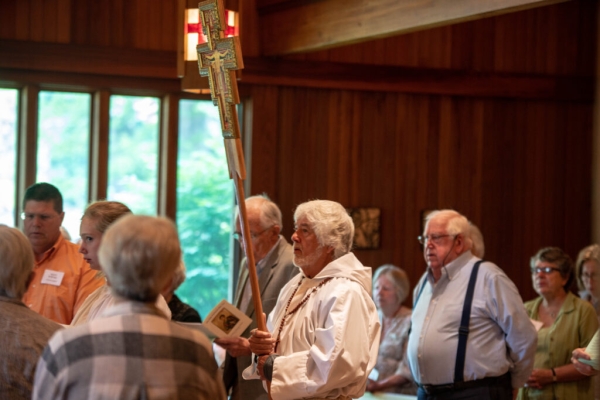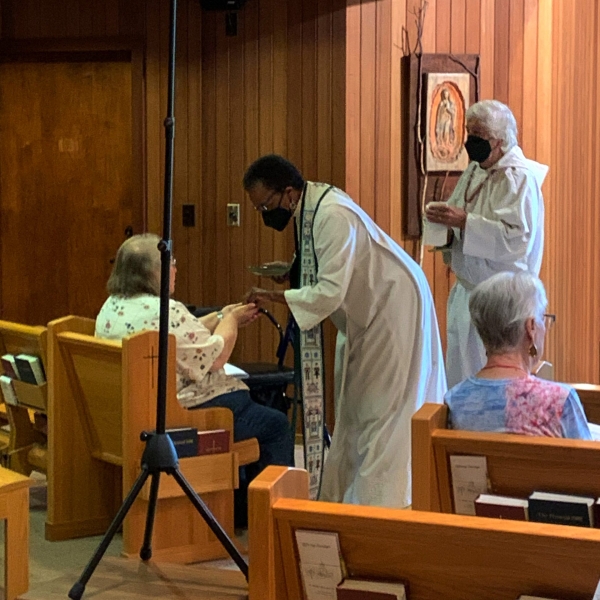If you are new St. Philip’s or the Episcopal tradition, you may have some questions about what to expect or how to participate in our worship service. This FAQ will help you understand some of the language and ritual in the Episcopal Church. We are happy to answer questions not addressed here; just drop us a note using our Contact Us form.
What is an Episcopalian?
 A person who belongs to the Episcopal Church is called an Episcopalian. The word Episcopal means a church governed by bishops. The Episcopal Church worships in the liturgical style, which means all Episcopal churches follow a similar order of service. The Episcopal Church is a member of the Anglican Communion and has descended from the Church of England and the Scottish Episcopal Church.
A person who belongs to the Episcopal Church is called an Episcopalian. The word Episcopal means a church governed by bishops. The Episcopal Church worships in the liturgical style, which means all Episcopal churches follow a similar order of service. The Episcopal Church is a member of the Anglican Communion and has descended from the Church of England and the Scottish Episcopal Church.
Is the Episcopal Church Protestant or Catholic?
Some people refer to the Anglican tradition as a “bridge” between Protestants and Catholics. The Episcopal Church is both catholic and reformed, meaning we retain the essential elements of the Catholic tradition, while also embracing some Protestant beliefs and practices. We share a liturgical, sacramental, and Apostolic tradition with the Catholic Church. The Episcopal Church’s beliefs are also rooted in many Protestant traditions. As such, we embrace aspects of both the Protestant and Catholic worship styles, beliefs, and actions. This explains why so many people from different faith backgrounds find a home in the Episcopal Church today.
The spiritual head of the worldwide Anglican Communion (which includes the Episcopal Church) is the Archbishop of Canterbury in England. Unlike the Pope of the Roman Catholic Church, the Archbishop serves only as a leader and guide and does not make rules or laws for the Church to follow.
Do you use the Bible?
 On Sundays, in most Episcopal churches, you will hear the same lessons from the Bible read, no matter where you go. That’s because the Episcopal Church follows the Revised Common Lectionary along with many other Christian denominations. Each week we hear God’s Word, broken into a three-year cycle, taking a portion from the Old Testament, Psalms, New Testament, and one of the Gospels each week. You’ll find our weekly readings here.
On Sundays, in most Episcopal churches, you will hear the same lessons from the Bible read, no matter where you go. That’s because the Episcopal Church follows the Revised Common Lectionary along with many other Christian denominations. Each week we hear God’s Word, broken into a three-year cycle, taking a portion from the Old Testament, Psalms, New Testament, and one of the Gospels each week. You’ll find our weekly readings here.
The Book of Common Prayer is used each week along with the Bible for prayer, sacraments, and church teachings.
What is a Diocese?
The word diocese (pronounced DY-oh-seas) comes from the Latin and Greek words for “administration.” The Episcopal Diocese of Western Michigan is one of 15 dioceses in the Fifth Province of the U.S. Episcopal Church. Each diocese is headed by a Bishop, and usually corresponds to a state or a portion of a state. An Episcopal diocese includes all the churches and missions within its borders. Our diocese comprises the entire western half of the lower peninsula of Michigan.
What is a Parish?
 Within each diocese are local churches called parishes, each of which is governed by an elected vestry (which is like a board of directors) of church members who help lead the church and make important day-to-day decisions. A Rector (clergy member) is the spiritual leader of the parish.
Within each diocese are local churches called parishes, each of which is governed by an elected vestry (which is like a board of directors) of church members who help lead the church and make important day-to-day decisions. A Rector (clergy member) is the spiritual leader of the parish.
Who are Clergy?
In the Episcopal tradition, ordained spiritual leaders are clergy. There are three types of clergy: deacons, priests (or rectors), and bishops. Parishes select their priest or priests, subject to the approval of the local bishop. The priest-in-charge may work with an assistant rector, deacon, and other clergy.
Priests may be any gender and may choose to marry or not – we think that’s a personal decision. Women, gender non-conforming, and LGBTQ+ people are welcome to serve as priests, deacons, lay leaders, vestry members – any role or mission in the church is open to anyone called to serve.
Click to learn more about the Episcopal Church organizational structure in Western Michigan.
Do you have to be an Episcopalian to go to an Episcopal Church?
 All people are welcome here, regardless of background. Many of our members come to us from other faith traditions and denominations. You’ll find a friendly community of people united by their faith in God, eagerness to serve others, and commitment to justice for people of all races, genders, and abilities.
All people are welcome here, regardless of background. Many of our members come to us from other faith traditions and denominations. You’ll find a friendly community of people united by their faith in God, eagerness to serve others, and commitment to justice for people of all races, genders, and abilities.
Does the Episcopal Church welcome LGBTQ+ people?
Absolutely. All of God’s children are welcome to participate at St. Philip’s and in the Episcopal Church, and to answer God’s call to service in a wide variety of roles and missions. LGBTQ+ persons are warmly welcome here, along with everyone else, in all orders of the church, lay and ordained.
What do Episcopalians believe?
There are three basic sources of Episcopal Church beliefs:
- Scripture (the primary source). The Old and New Testaments contain the essence of Christian doctrine. They reveal God to humankind and tell of our response to God in history. The Bible helps us to know God’s will, revealed supremely through the life, death, and resurrection of Jesus. The Scriptures are the word of God, proclaiming that Jesus – both God and human being – is Christ, the Messiah.
- Reason (gifts of the Holy Spirit). The Episcopal Church does not control interpretation of God’s word and practice of faith. Church members are encouraged to use reason to explore and comprehend God’s works; to make responsible moral decisions under the guidance of Scripture and clergy, and in response to sincere prayer.
- Tradition (wisdom of generations past). Tradition helps us interpret Scripture; lets us share experiences of early Christians and believers of every era; preserves hymns, prayers, and practices that keep our faith alive; and strengthens our faith. Through its continuity and consistency, tradition helps preserve essential truths through liturgy. For example, The Book of Common Prayer tells us that private worship, while important, is not adequate, the Christian faith is communal; and the Episcopal Church’s worship is participatory. Religion is a fellowship. You relate to the whole church through your parish and your church community.
Learn more about what we believe on the Episcopal Church website.
What does the Priest wear?
 At St. Philip’s, you’ll probably see our priest in an alb, a white tunic that covers the body from neck to ankles. Ordained ministers wear a stole, a narrow band of colored fabric, over the alb, and for a service of the Holy Eucharist a bishop or priest frequently wears a chasuble (a circular garment like a poncho) over the alb and stole. Bishops sometimes wear a special head covering called a mitre (affectionately referred to as the pointy hat). Vestment colors change with the seasons and holy days of the Church Year. The most frequently used colors are white, blue, red, purple, and green.
At St. Philip’s, you’ll probably see our priest in an alb, a white tunic that covers the body from neck to ankles. Ordained ministers wear a stole, a narrow band of colored fabric, over the alb, and for a service of the Holy Eucharist a bishop or priest frequently wears a chasuble (a circular garment like a poncho) over the alb and stole. Bishops sometimes wear a special head covering called a mitre (affectionately referred to as the pointy hat). Vestment colors change with the seasons and holy days of the Church Year. The most frequently used colors are white, blue, red, purple, and green.
What is the Episcopal Church’s position on “hot topics” such as abortion, gay rights and political affiliation? Will they tell me how to think, how to act or how to vote?
The Episcopal Church doesn’t tell anyone to vote or think in a certain way. Members are encouraged to pray, meditate, read, and discuss these topics – and then, with help from the Holy Spirit, make informed decisions. We do not endorse political candidates or parties or any specific public policy.
To learn more about the Episcopal Church and St. Philip’s, please visit:
The Episcopal Church is a member of the Worldwide Anglican Communion, a network of churches that share Church of England roots.
The Episcopal Church Official Website
The Episcopal Diocese of Western Michigan
Daily Office–Morning & Evening Prayer The Daily Office has its roots that stretch deep, dating back to the first Monastics. Daily Morning and Evening Prayer, along with the other offices in our Book of Common Prayer, offer a way to pray together, as a worldwide church, at common times. It’s a powerful practice that enriches what we do when we gather on Sundays.
2020 Stewardship Booklet: Our people

